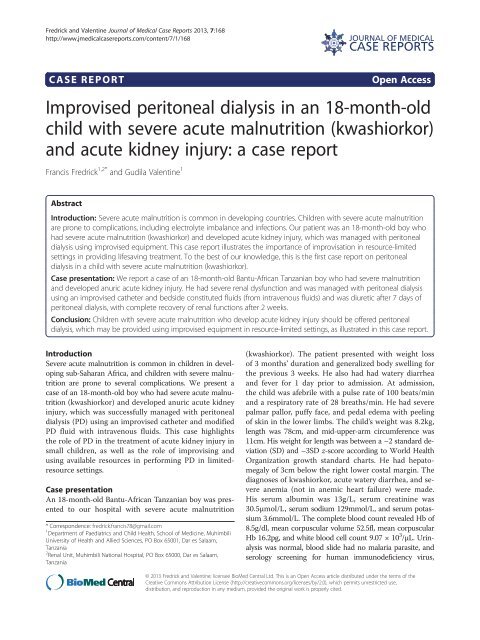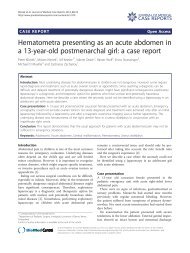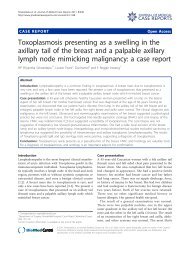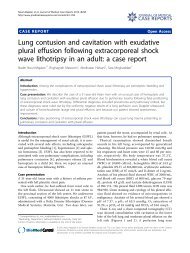Provisional PDF - Journal of Medical Case Reports
Provisional PDF - Journal of Medical Case Reports
Provisional PDF - Journal of Medical Case Reports
You also want an ePaper? Increase the reach of your titles
YUMPU automatically turns print PDFs into web optimized ePapers that Google loves.
Fredrick and Valentine <strong>Journal</strong> <strong>of</strong> <strong>Medical</strong> <strong>Case</strong> <strong>Reports</strong> 2013, 7:168<br />
http://www.jmedicalcasereports.com/content/7/1/168<br />
JOURNAL OF MEDICAL<br />
CASE REPORTS<br />
CASE REPORT<br />
Open Access<br />
Improvised peritoneal dialysis in an 18-month-old<br />
child with severe acute malnutrition (kwashiorkor)<br />
and acute kidney injury: a case report<br />
Francis Fredrick 1,2* and Gudila Valentine 1<br />
Abstract<br />
Introduction: Severe acute malnutrition is common in developing countries. Children with severe acute malnutrition<br />
are prone to complications, including electrolyte imbalance and infections. Our patient was an 18-month-old boy who<br />
had severe acute malnutrition (kwashiorkor) and developed acute kidney injury, which was managed with peritoneal<br />
dialysis using improvised equipment. This case report illustrates the importance <strong>of</strong> improvisation in resource-limited<br />
settings in providing lifesaving treatment. To the best <strong>of</strong> our knowledge, this is the first case report on peritoneal<br />
dialysis in a child with severe acute malnutrition (kwashiorkor).<br />
<strong>Case</strong> presentation: We report a case <strong>of</strong> an 18-month-old Bantu-African Tanzanian boy who had severe malnutrition<br />
and developed anuric acute kidney injury. He had severe renal dysfunction and was managed with peritoneal dialysis<br />
using an improvised catheter and bedside constituted fluids (from intravenous fluids) and was diuretic after 7 days <strong>of</strong><br />
peritoneal dialysis, with complete recovery <strong>of</strong> renal functions after 2 weeks.<br />
Conclusion: Children with severe acute malnutrition who develop acute kidney injury should be <strong>of</strong>fered peritoneal<br />
dialysis, which may be provided using improvised equipment in resource-limited settings, as illustrated in this case report.<br />
Introduction<br />
Severeacutemalnutritioniscommoninchildrenindeveloping<br />
sub-Saharan Africa, and children with severe malnutrition<br />
are prone to several complications. We present a<br />
case <strong>of</strong> an 18-month-old boy who had severe acute malnutrition<br />
(kwashiorkor) and developed anuric acute kidney<br />
injury, which was successfully managed with peritoneal<br />
dialysis (PD) using an improvised catheter and modified<br />
PD fluid with intravenous fluids. This case highlights<br />
the role <strong>of</strong> PD in the treatment <strong>of</strong> acute kidney injury in<br />
small children, as well as the role <strong>of</strong> improvising and<br />
using available resources in performing PD in limitedresource<br />
settings.<br />
<strong>Case</strong> presentation<br />
An 18-month-old Bantu-African Tanzanian boy was presented<br />
to our hospital with severe acute malnutrition<br />
* Correspondence: fredrick.francis78@gmail.com<br />
1 Department <strong>of</strong> Paediatrics and Child Health, School <strong>of</strong> Medicine, Muhimbili<br />
University <strong>of</strong> Health and Allied Sciences, PO Box 65001, Dar es Salaam,<br />
Tanzania<br />
2 Renal Unit, Muhimbili National Hospital, PO Box 65000, Dar es Salaam,<br />
Tanzania<br />
(kwashiorkor). The patient presented with weight loss<br />
<strong>of</strong> 3 months’ duration and generalized body swelling for<br />
the previous 3 weeks. He also had had watery diarrhea<br />
and fever for 1 day prior to admission. At admission,<br />
the child was afebrile with a pulse rate <strong>of</strong> 100 beats/min<br />
andarespiratoryrate<strong>of</strong>28breaths/min.Hehadsevere<br />
palmar pallor, puffy face, and pedal edema with peeling<br />
<strong>of</strong> skin in the lower limbs. The child’s weight was 8.2kg,<br />
length was 78cm, and mid-upper-arm circumference was<br />
11cm. His weight for length was between a –2 standarddeviation<br />
(SD) and –3SD z-score according to World Health<br />
Organization growth standard charts. He had hepatomegaly<br />
<strong>of</strong> 3cm below the right lower costal margin. The<br />
diagnoses <strong>of</strong> kwashiorkor, acute watery diarrhea, and severe<br />
anemia (not in anemic heart failure) were made.<br />
His serum albumin was 13g/L, serum creatinine was<br />
30.5μmol/L, serum sodium 129mmol/L, and serum potassium<br />
3.6mmol/L. The complete blood count revealed Hb <strong>of</strong><br />
8.5g/dl, mean corpuscular volume 52.5fl, mean corpuscular<br />
Hb 16.2pg, and white blood cell count 9.07 × 10 3 /μL. Urinalysis<br />
was normal, blood slide had no malaria parasite, and<br />
serology screening for human immunodeficiency virus,<br />
© 2013 Fredrick and Valentine; licensee BioMed Central Ltd. This is an Open Access article distributed under the terms <strong>of</strong> the<br />
Creative Commons Attribution License (http://creativecommons.org/licenses/by/2.0), which permits unrestricted use,<br />
distribution, and reproduction in any medium, provided the original work is properly cited.
Fredrick and Valentine <strong>Journal</strong> <strong>of</strong> <strong>Medical</strong> <strong>Case</strong> <strong>Reports</strong> 2013, 7:168 Page 2 <strong>of</strong> 4<br />
http://www.jmedicalcasereports.com/content/7/1/168<br />
Figure 1 Suprapubic aspiration catheter modified into a peritoneal dialysis catheter by cutting holes in the distal part <strong>of</strong> the catheter.<br />
hepatitis B virus, and hepatitis C virus was normal. The<br />
child was treated with special diet Formula 75, low osmolarity<br />
oral rehydration solution, pediatric zinc, folic acid,<br />
and vitamin A. The child was put on the intravenous antibiotics<br />
ampicillin, cloxacillin, and gentamicin for 7 days.<br />
The patient’s diarrhea stopped on his fourth day in the<br />
ward, edema <strong>of</strong> his lower limbs subsided, and he had no<br />
fever. On the seventh day postadmission, the boy’s Formula<br />
75 diet was changed to Formula 100. On the ninth<br />
day after his admission, he had reduced urine output<br />
(24-hour urine output 20ml), no fever, no hematuria,<br />
and no skin infection, but he had a reappearance <strong>of</strong> puffy<br />
face. Furosemide injection was given to challenge the<br />
kidneys, which brought no improvement. The child was<br />
anuric on the tenth day postadmission. A diagnosis <strong>of</strong><br />
acute anuric kidney injury was made. His serum creatinine<br />
was 85.7μmol/L, serum potassium was 4.1mmol/L, and<br />
serum sodium was 132mmol/L. Daily input was restricted<br />
to 500ml, the child was monitored with serial serum creatinine<br />
and electrolytes, and he was anuric for a total <strong>of</strong><br />
5 days, after which PD was started. Before PD, his serum<br />
creatinine was 256μmol/L, serum potassium was 4.7mmol/L,<br />
and sodium was 127mmol/L.<br />
PD was carried out using a suprapubic aspiration catheter<br />
as a PD catheter; this was modified by cutting small side<br />
holes (Figure 1). The modified catheter was introduced<br />
into the peritoneal cavity after making a small incision<br />
and dissection <strong>of</strong> tissues to the rectus sheath under aseptic<br />
conditions, and this procedure was performed under local<br />
anesthesia using 2% lignocaine. PD fluid was made at bedside<br />
using 250ml <strong>of</strong> 5% dextrose solution, 750ml <strong>of</strong> 0.9%<br />
normal saline, 40ml <strong>of</strong> 8.4% sodium bicarbonate, 7.5ml <strong>of</strong><br />
10% calcium gluconate, 1000 units <strong>of</strong> heparin and 250mg<br />
<strong>of</strong> ceftriaxone (Figure 2). Dwell time was 30 minutes for<br />
Figure 2 Peritoneal dialysis fluid made at bedside using 250ml <strong>of</strong> 5% dextrose solution, 750ml <strong>of</strong> 0.9% normal saline, 40ml <strong>of</strong> 8.4%<br />
sodium bicarbonate, 7.5ml <strong>of</strong> 10% calcium gluconate, 1000U <strong>of</strong> heparin, and 250mg <strong>of</strong> ceftriaxone.
Fredrick and Valentine <strong>Journal</strong> <strong>of</strong> <strong>Medical</strong> <strong>Case</strong> <strong>Reports</strong> 2013, 7:168 Page 3 <strong>of</strong> 4<br />
http://www.jmedicalcasereports.com/content/7/1/168<br />
the first exchange and 2 hours for subsequent 2 exchanges<br />
and 6 hourly thereafter. Dwell volumes were 250ml for<br />
the first two dwells, and was reduced to 200ml for subsequent<br />
dwells because <strong>of</strong> leakage. The child was also given<br />
ceftriaxone injection 500mg once daily at initiation <strong>of</strong> PD.<br />
Serum creatinine peaked at 384.6μmol/L on day 3 <strong>of</strong> PD,<br />
and serum electrolytes were within normal range. The<br />
child was kept on PD for 7 days, and he started to pass<br />
urine (20ml) on the 4 th day after starting PD, on the<br />
5 th day urine output increased to 80ml and on the 6 th day<br />
the child passed 340ml <strong>of</strong> urine. The PD catheter was<br />
removed on the 7 th day after starting PD.<br />
The child’s condition improved after PD, and his serum<br />
creatinine level decreased gradually. The child was continued<br />
on the Formula 100 diet and was given ferrous sulfate<br />
tablets for iron deficiency anemia. An abdominal ultrasound<br />
was performed after stopping PD, which revealed<br />
normal-sized kidneys with normal cortical medullary differentiation.<br />
The patient was discharged 2 weeks after PD<br />
was stopped, at which time his serum creatinine was<br />
41. 4μmol/L. The child was seen 2 weeks later in the<br />
follow-up clinic and was doing fine, and his serum creatinine<br />
was 32.8μmol/L.<br />
Discussion<br />
Severe malnutrition is common in children, especially<br />
in sub-Sahara Africa, and these children are susceptible<br />
to various complications, including hypoglycemia, hypothermia,<br />
electrolyte imbalance, and infections [1-3].<br />
Children with severe acute malnutrition are treated in<br />
phases, with the first phase being stabilization with an<br />
emphasis on treating infections and replenishing the<br />
deficient micronutrients. In this phase, the patients are<br />
mainly given a Formula 75 diet, which is low in energy<br />
and protein contents [1]. After stabilization, patients are<br />
fed a Formula 100 diet, which is rich in energy and protein<br />
for catch-up growth [1].<br />
In the present case report, we describe a peculiar case<br />
<strong>of</strong> severe acute malnutrition complicated by severe acute<br />
kidney injury. The cause <strong>of</strong> acute kidney injury could not<br />
be clearly identified but was attributed to various factors,<br />
including infection and nephrotoxic drugs (especially gentamicin)<br />
which the patient had received. Acute kidney injuries<br />
in children are usually multifactorial [4].<br />
Our patient developed anuric acute kidney injury, and<br />
the patient was successfully managed with acute PD using<br />
an improvised catheter (Figure 1) and PD fluids which were<br />
prepared at bedside using intravenous fluids (Figure 2). PD<br />
is the modality <strong>of</strong> choice in managing acute renal failure<br />
in children [5], with the advantages <strong>of</strong> being easy to perform<br />
without requirement <strong>of</strong> sophisticated equipment as compared<br />
to hemodialysis [6]. The outcome <strong>of</strong> children with<br />
acute kidney injury treated with PD has been reported to be<br />
remarkably good [7,8].<br />
Access to PD is universal in developed countries but<br />
not as prevalent in developing countries [9]. Initiatives<br />
to establish PD in resource-limited settings have proved<br />
to be successful, as reported by Callegari et al. on PD for<br />
treatment <strong>of</strong> acute kidney injury in Kilimanjaro, Tanzania<br />
[10]. In our hospital, we had no acute PD catheter or<br />
fluids, which necessitated this improvised technique in<br />
managing acute kidney injury. Our patient had kwashiorkor<br />
and developed acute kidney injury, and he was treated with<br />
improvised PD as a modality <strong>of</strong> renal replacement therapy,<br />
which led to a good outcome. A similar approach was<br />
reported by Obiagwu et al. in a child with acute kidney<br />
injury in Kano, Nigeria [11]. This shows that a patient<br />
with kwashiorkor who develops acute kidney injury may<br />
benefit from renal replacement therapy in the form <strong>of</strong> PD.<br />
Conclusion<br />
Children with severe malnutrition who develop acute<br />
kidney injury should be <strong>of</strong>fered PD as a modality <strong>of</strong> renal<br />
replacement therapy. In resource-limited settings, lifesaving<br />
PD may be provided by improvising locally available<br />
equipment and intravenous fluids, as illustrated in this<br />
case report.<br />
Consent<br />
Written informed consent was obtained from the patient’s<br />
legal guardian for publication <strong>of</strong> this manuscript and<br />
accompanying images. A copy <strong>of</strong> the written consent is<br />
available for review by the Editor-in-Chief <strong>of</strong> this journal.<br />
Abbreviations<br />
HBV: Hepatitis B virus; HCV: Hepatitis C virus; HIV: Human immunodeficiency<br />
virus; MCH: Mean corpuscular hemoglobin; MCV: Mean corpuscular volume;<br />
SD: Standard deviation; WHO: World Health Organization.<br />
Competing interests<br />
The authors declare that they have no competing interests.<br />
Authors’ contributions<br />
FF analyzed and interpreted patient data and wrote the manuscript. GV<br />
gathered patient data and participated in its analysis. Both authors read and<br />
approved the final manuscript.<br />
Acknowledgments<br />
We are very grateful to the nurses in the pediatric diarrhea ward who were<br />
very supportive in providing care to this patient and assisted in gathering<br />
the patient’s information for this write up.<br />
Received: 6 February 2013 Accepted: 31 May 2013<br />
Published: 28 June 2013<br />
References<br />
1. Department <strong>of</strong> Child and Adolescent Health and Development (CAH),<br />
UNICEF, World Health Organization: Handbook: IMCI integrated management<br />
<strong>of</strong> childhood illness. Geneva: Author; 2005. Available at: http://whqlibdoc.<br />
who.int/publications/2005/9241546441.pdf.<br />
2. Mahgoub HM, Adam I: Morbidity and mortality <strong>of</strong> severe malnutrition<br />
among Sudanese children in New Halfa Hospital, Eastern Sudan. Trans R<br />
Soc Trop Med Hyg 2011, 106:66–68.<br />
3. Bachou H, Tylleskär T, Downing R, Tumwine JK: Severe malnutrition with<br />
and without HIV-1 infection in hospitalised children in Kampala, Uganda:
Fredrick and Valentine <strong>Journal</strong> <strong>of</strong> <strong>Medical</strong> <strong>Case</strong> <strong>Reports</strong> 2013, 7:168 Page 4 <strong>of</strong> 4<br />
http://www.jmedicalcasereports.com/content/7/1/168<br />
differences in clinical features, haematological findings and CD4 + cell<br />
counts. Nutr J 2006, 5:27.<br />
4. Andreoli SP: Acute kidney injury in children. Pediatr Nephrol 2009, 24:253–263.<br />
5. Strazdins V, Watson AR, Harvey B: Renal replacement therapy for acute<br />
renal failure in children: European guidelines. Pediatr Nephrol 2004,<br />
19:199–207.<br />
6. Walters S, Porter C, Brophy PD: Dialysis and pediatric acute kidney injury:<br />
choice <strong>of</strong> renal support modality. Pediatr Nephrol 2009, 24:37–48.<br />
7. Anochie IC, Eke FU: Paediatric acute peritoneal dialysis in southern Nigeria.<br />
Postgrad Med J 2006, 82:228–230.<br />
8. Kandoth PW, Agarwal GJ, Dharnidharka VR: Acute renal failure in children<br />
requiring dialysis therapy. Indian Pediatr 1994, 31:305–309.<br />
9. Phadke KD, Dinaker C: The challenges <strong>of</strong> treating children with renal<br />
failure in a developing country. Perit Dialysis Int 2001, 21:s326–s329.<br />
10. Callegari JG, Kilonzo KG, Yeates KE, Handelman GJ, Finkelstein FO, Kontanko P,<br />
Levin NW, Carter M: Peritoneal dialysis for acute kidney injury in sub-Saharan<br />
Africa: challenges faced and lessons learned at Kilimanjaro Christian <strong>Medical</strong><br />
Centre. Kidney Int 2012, 81:331–333.<br />
11. Obiagwu PN, Gwarzo GD, Akhiwu H, Wada A: Managing acute kidney<br />
injury in a child with improvised peritoneal dialysis in Kano, Nigeria.<br />
Niger J Basic Clin Sci 2012, 9:84–86.<br />
doi:10.1186/1752-1947-7-168<br />
Cite this article as: Fredrick and Valentine: Improvised peritoneal dialysis<br />
in an 18-month-old child with severe acute malnutrition (kwashiorkor)<br />
and acute kidney injury: a case report. <strong>Journal</strong> <strong>of</strong> <strong>Medical</strong> <strong>Case</strong> <strong>Reports</strong><br />
2013 7:168.<br />
Submit your next manuscript to BioMed Central<br />
and take full advantage <strong>of</strong>:<br />
• Convenient online submission<br />
• Thorough peer review<br />
• No space constraints or color figure charges<br />
• Immediate publication on acceptance<br />
• Inclusion in PubMed, CAS, Scopus and Google Scholar<br />
• Research which is freely available for redistribution<br />
Submit your manuscript at<br />
www.biomedcentral.com/submit








